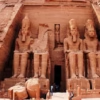The Temple of Karnak in Luxor is one of the most impressive structures of ancient Egypt. As the largest temple complex in the world, it was the religious center of the cult of Amun for over two millennia. With its gigantic colonnades, obelisks, and statues, it reflects the power and beliefs of the pharaohs. This article explores the history, architecture, and significance of the Temple of Karnak.

Historical development
Construction of the Temple of Karnak began in the Middle Kingdom (around 2000 BC) and was expanded over more than 1500 years. Almost every important pharaoh left his mark here:
Thutmose III built the famous festival temple.
Hatshepsut had two huge obelisks erected.
Ramses II added monumental statues and pylons.
The Ptolemies finally completed some of the last structures.
The temple was not only a place of worship, but also a symbol of political power.
Architecture and structure
The Karnak Temple consists of three main areas:
The Amun district (the largest part with the Hypostyle Hall)
The Mut district (dedicated to the goddess Mut)
The Month district (for the god of war, Month)
Notable structures:
The Great Hypostyle Hall: With 134 columns up to 24 meters high.
The Sacred Lake: An artificial lake for ritual washings.
The Avenue of Sphinxes: Connects Karnak with the Luxor Temple.
Religious significance
Karnak was the center of the cult of Amun, one of the most important gods in Egypt. Major festivals were held here, such as the Opet Festival, during which statues of the gods were carried in procession to the Luxor Temple. The priests of Karnak wielded immense political power and controlled vast estates.

Discovery and modern significance
After the decline of ancient Egypt, Karnak was buried by sand and only systematically explored in the 19th century. Today, it is one of Egypt’s most important tourist attractions and a UNESCO World Heritage Site. Archaeologists continue to work on unraveling the mysteries of the temple.
Conclusion
The Karnak Temple is not only an architectural marvel, but also a testament to Egypt’s religious and political history. Its monumental structures fascinate visitors and researchers alike, making it one of the most important ancient sites in the W.





